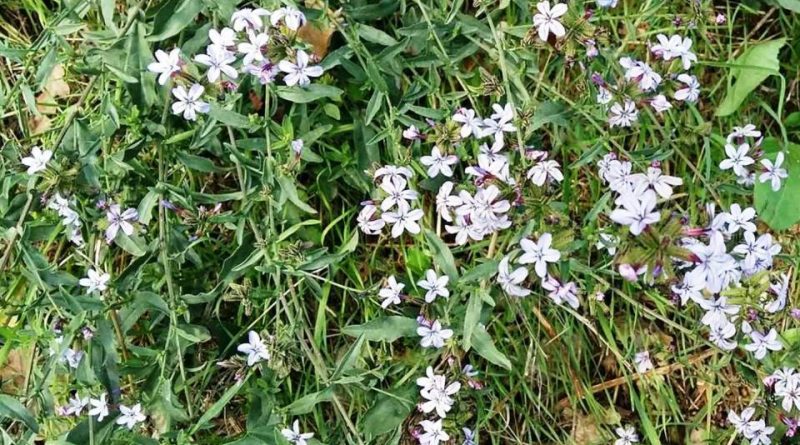Plumbago europaea
Plumbago europaea
The common leadwort (Plumbago europaea L.) is a herbaceous species belonging to the Plumbaginaceae family.
Systematics –
From a systematic point of view it belongs to:
Eukaryota Domain,
Kingdom Plantae,
Subarign Tracheobionta,
Spermatophyta superdivision,
Magnoliophyta Division,
Magnoliopsida class,
Order Plumbaginales,
Plumbaginaceae family,
Genus Plumbago,
P. europaea species.
The following terms are synonymous:
– Plumbago angustifolia Spach;
– Plumbago denticulata St. Lager;
– Plumbago europaea var. asperrima Sennen & Elías;
– Plumbago europaea var. glandulosa Cout .;
– Plumbago lapathifolia Willd .;
– Plumbago purpurea Salisb .;
– Plumbago undulata Moench ..
Etymology –
The term Plumbago comes from plumbago, the Latin name of a plant mentioned by Pliny.
The specific epithet europaea comes from Europe: as a species of the European continent.
Geographic Distribution and Habitat –
Plumbago europaea is a plant of Southern Europe origin, in the Mediterranean area and widespread as far as Central Asia.
In all of Italy it is present throughout the central-southern sector, including the islands and as an adventitious in Veneto.
Its habitat is those of dry rocky areas, hills, maritime sands, roadsides, fields and walls at altitudes between 0-800 meters above sea level.
Description –
Plumbago europaea is a perennial herbaceous plant with a woody base, camefite fruticosa, covered by a consistent cottony layer which, in optimal conditions, forms a roundish bush up to about one meter high.
The basal portion is very branchy, compact, intricate and partly lignified. Numerous flower stems, which are also widely branched, radiate from it. The stems are erect, hairless and ribbed.
The leaves vary in shape and size and are often densely covered on both sides with tiny glands. The lower leaves are lanceolate with a cuneate base, the cauline ones are smaller, more strictly lanceolate, with a corded base, sessile and embracing cauli; they have entire margins but sometimes appears as indented due to the presence of a regular row of prominent papillae. The leaves have mostly a grayish, leaden color.
The flowers are hermaphroditic and collected in pauciflorous tops at the apex of the main and secondary branches. The glass has a tubular shape and a reddish color; it is characterized, quite conspicuously, by the presence on the sepals of ordered lines of prominent glandular hairs. The corolla is also tubular and is divided into five lanceolate lobes. The color is purplish-pink of varying intensity and the central rib of the individual lobes is of a more intense shade.
The anthesis is between the months of June-October.
The fruit is an oblong ovoid diclesium, 6,2-7 x 2,6-3 mm, dark, bright, transversely dehiscent from the base to the apex, often for 5 valves. Single seed, approximately 4-4.5 x 2.2-3 mm, in the shape of a drop, with one end pointed and the other rounded.
Cultivation –
Plumbago europaea is a rare perennial plant that, especially in the past, was used in nature for local use as a food.
It is a plant that can be grown in well-drained sandy or gravelly soils in full sun.
Propagation occurs by seed with sowing in seedbeds in early spring or directly in the open field.
The transplant in open field must be done in late spring after the last frosts foreseen.
It can also be propagated by cuttings of the basal shoots of the new spring vegetation. In this case it is recommended to take the shoots with abundant underground stem when they are about 8 – 10 cm from the ground. They should then be placed in the light shade or in a protected area until rooting and transplanted in summer.
Customs and Traditions –
Plumbago europaea is a plant used both in the medicinal and food fields.
It is sometimes cultivated as an ornamental plant and often escapes cultivation by growing on uncultivated grounds, at the edges of roads, sometimes even on walls, with optimum in the Mediterranean belt.
For medicinal use it is used as an emetic, odontalgic, vesicant.
Europetin flavonol is extracted from this plant, which is an O-methylated flavonol and can be synthetically prepared.
For edible use, the young leaves are used and eaten cooked.
Preparation Method –
Common leadwort is a plant used, especially once for medicinal or food purposes.
The young leaves of this plant are used for food or roots and the whole plant for medicinal use.
Guido Bissanti
Sources
– Acta Plantarum – Flora of the Italian Regions.
– Wikipedia, the free encyclopedia.
– Useful Tropical Plants Database.
– Conti F., Abbate G., Alessandrini A., Blasi C. (ed.), 2005. An annotated checklist of the Italian vascular flora, Palombi Editore.
– Pignatti S., 1982. Flora of Italy, Edagricole, Bologna.
– Treben M., 2000. Health from the Lord’s Pharmacy, Advice and experiences with medicinal herbs, Ennsthaler Editore.
Warning: Pharmaceutical applications and alimurgical uses are indicated for informational purposes only, they do not represent in any way a medical prescription; therefore no responsibility is taken for their use for curative, aesthetic or food purposes.


